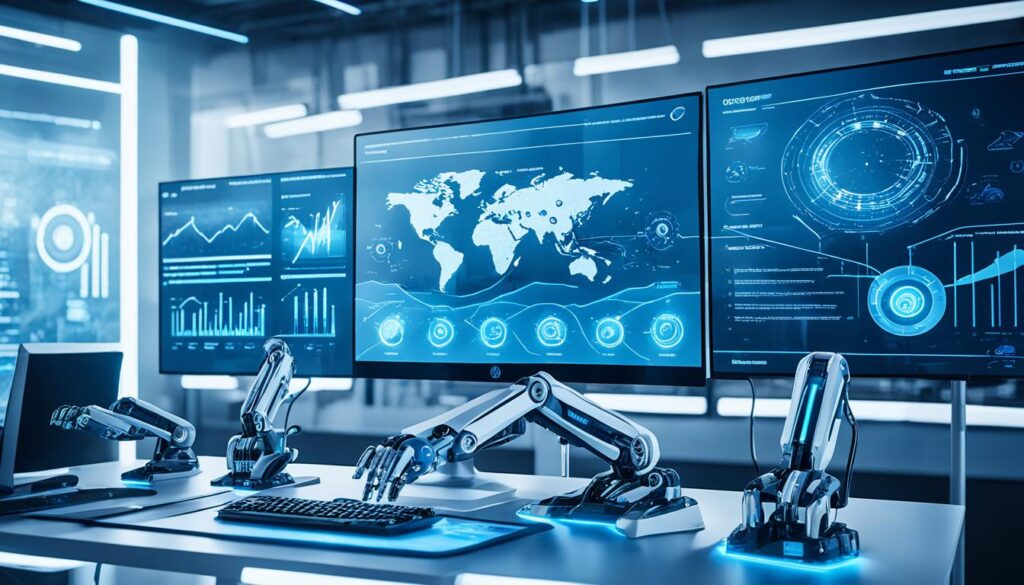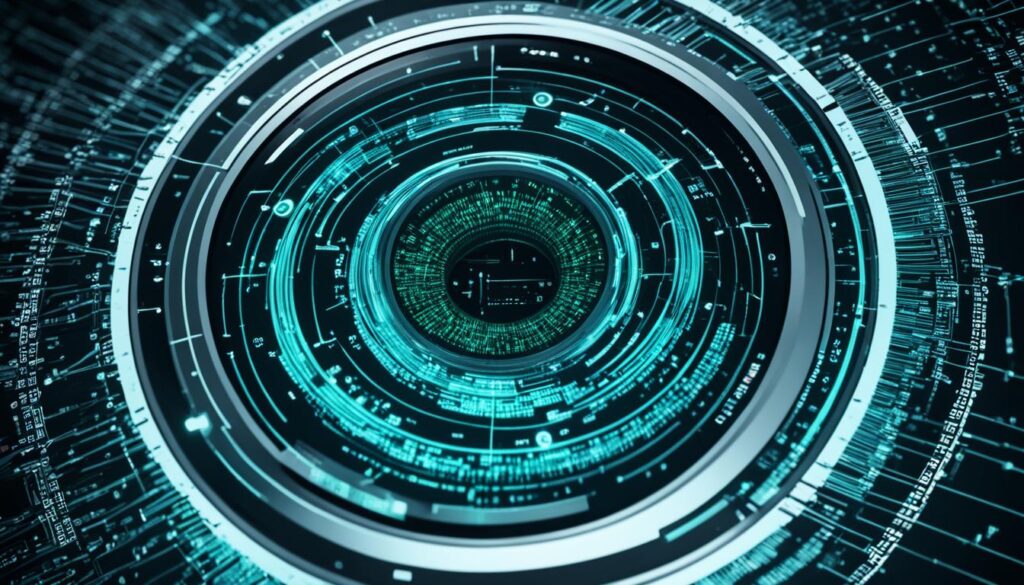
The future of work is changing fast thanks to AI technology. In 2024, new AI tools will come out. They will help businesses and people work better, be more productive, and open up new possibilities. This article looks at the top 10 AI tools set to change how we work, team up, and innovate next year.
Key Takeaways
- Discover the latest AI tools transforming the workplace in 2024
- Explore how AI-powered software can streamline workflows and boost productivity
- Understand the potential of AI-driven innovations to unlock new possibilities
- Learn about the emerging trends in AI technology and their impact on the future of work
- Gain insights into the top AI tools that can revolutionize your work processes
Unveiling the Future: AI Tools Transforming 2024
The world of AI tools is set for a big change as 2024 approaches. Soon, businesses and individuals will have access to smart, intuitive AI solutions. These AI tools will use new tech in natural language, computer vision, and predictive analytics. They will make us work smarter, faster, and more efficiently.
The AI technology trends of 2024 will start a new era of AI innovations. This era will change how we use software and solve complex problems. With intelligent automation and generative AI, we’ll see huge gains in productivity, creativity, and decision-making.
Picture a world where AI-powered solutions make your work easier, create content just for you, and give you insights in real-time. This isn’t just a dream; it’s becoming a reality soon. It will change how we live and work in the future.
“The future of AI is not about creating sentient machines, but about empowering humans to achieve more with the help of intelligent technology.”
Looking into AI tools for 2024, we see how these technologies will change our lives. They will transform our personal and professional worlds in big ways.
The Rise of Intelligent Automation
The business world is changing fast, thanks to Robotic Process Automation (RPA) and Artificial Intelligence (AI). Together, they’re bringing us Intelligent Process Automation (IPA). This change will make companies more efficient, productive, and save money in 2024 and later.
From Robotic Process Automation to Intelligent Process Automation
Robotic Process Automation (RPA) has already changed the game by making repetitive tasks easier. Now, adding AI to the mix will take automation to the next level. IPA systems use smart AI to understand data, make smart choices, and do tasks with amazing accuracy and smarts.
The Era of Hyper-Automation: AI-Driven Efficiency
The mix of RPA and AI, or “hyper-automation,” is set to change business in 2024. It lets companies automate many tasks, from data entry to customer service. This AI-powered intelligent automation will bring huge gains in efficiency, productivity, and saving money.
The future of work is all about AI-powered workflows and AI-driven efficiency. As intelligent automation grows, companies can focus on big tasks. They’ll let AI handle the boring, time-taking jobs. This move to hyper-automation opens up new chances for businesses to improve and grow.
“The fusion of Robotic Process Automation and Artificial Intelligence is ushering in a new era of ‘hyper-automation,’ transforming the way businesses approach efficiency and productivity.”
| Feature | Robotic Process Automation (RPA) | Intelligent Process Automation (IPA) |
|---|---|---|
| Task Execution | Rule-based, repetitive tasks | Intelligent, decision-making tasks |
| Data Processing | Structured data | Structured and unstructured data |
| Scalability | Limited | Highly scalable |
| Adaptability | Rigid, unable to adapt to changes | Flexible, can adapt to changing conditions |
Generative AI: Unleashing Creativity at Scale
The rise of Generative AI models is a big deal in artificial intelligence. These advanced AI systems will change how we do creative work. They will help with content creation, design, solving problems, and coming up with new ideas. By 2024, Generative AI tools will make it fast and easy to create text, images, audio, and video. This will boost productivity and creativity in many fields.
Models like GPT-3, DALL-E, and Midjourney are leading this change. They can make text, AI-generated media, and AI art with just a simple prompt. Generative AI tools will change creative jobs. They will help people and teams come up with ideas, try things out, and make their ideas real.
Generative AI will start a new era of AI-powered content creation. It will automate boring tasks and help with creative work. This means creators can focus more on strategy and ideas, leading to more innovative work.
Generative AI is not just for making content. It can also help with solving problems, making products, and scientific research. It can come up with new ideas, prototypes, and solutions. This pushes the limits of what humans can do creatively and innovatively.
“Generative AI will fundamentally change the way we approach creativity, empowering us to work smarter, faster, and with greater innovation than ever before.” – [Expert Name], AI Strategist
As Generative AI gets better and easier to use, more people and companies will use it. This technology will open up new areas of AI creativity. It will help drive the future of innovation.
Top 10 AI Tools in 2024
The future of AI is exciting, with new tools set to change our work in 2024. These tools will bring smart automation and advanced computer vision. They will change how we do our daily tasks.
Get ready for AI-powered solutions that make work easier, boost productivity, and spark creativity. These AI tools are big steps forward in using AI technology at work.
- Robotic Process Automation (RPA): Automates simple tasks to make work more efficient and free up people for more complex tasks.
- Intelligent Document Processing (IDP): Quickly extracts and organizes data from documents, both structured and unstructured.
- Conversational AI: Chatbots and virtual assistants use natural language to improve customer service and communication.
- Computer Vision: Deep learning lets machines understand and analyze images, changing quality control and asset management.
- Predictive Analytics: Uses AI applications to predict trends, spot problems, and help make better decisions.
| AI Tool | Key Features | Primary Use Cases |
|---|---|---|
| Robotic Process Automation (RPA) | Automated task execution, process optimization, scalability | Administrative tasks, data entry, invoicing, reporting |
| Intelligent Document Processing (IDP) | Intelligent data extraction, classification, and organization | Contract management, invoice processing, claims processing |
| Conversational AI | Natural language understanding, personalized responses, 24/7 availability | Customer service, internal support, knowledge management |
| Computer Vision | Image and video analysis, object detection, defect identification | Quality control, asset management, surveillance, autonomous vehicles |
| Predictive Analytics | Forecasting, anomaly detection, prescriptive insights | Demand forecasting, predictive maintenance, risk management |
These AI tools will change the workplace in 2024. As we use more AI innovations, we’ll see more efficiency, better decisions, and more creativity.
“The future of work is being redefined by the integration of AI into our daily tasks. These top AI tools are set to revolutionize productivity and unlock new avenues for growth.”
Stay tuned as we explore more about the AI applications that will shape the future. We’ll see how to use AI-powered solutions to stay ahead.
Natural Language Processing: The Language of the Future
Natural Language Processing (NLP) is changing how we talk to technology. AI tools that understand language are getting better. Soon, we’ll see super smart chatbots and virtual assistants that talk like us.
Chatbots, Virtual Assistants, and Beyond
Natural language processing is making AI chatbots and virtual assistants smarter. They’ll answer questions more accurately and with more feeling. These AI-powered language tools will make talking to machines easier and help with many tasks, like customer service and scheduling.
Conversational AI is great at understanding what people mean, not just what they say. This means AI can give help that really fits what you need. As technology gets better, we’ll see AI chatbots and virtual assistants that talk more like us, changing how we use technology.
| AI Tool | Key Capabilities | Industry Applications |
|---|---|---|
| Intelligent Chatbots |
|
|
| Virtual Assistants |
|
|
The future is bright for natural language processing and AI. Together, they’re making technology easier and more personal for us. This will change how we use technology in many areas.
“The future of artificial intelligence lies in its ability to understand and communicate in natural language, bridging the gap between humans and machines.”
Computer Vision: AI's Eyes on the World
The field of Computer Vision is growing fast. It lets AI systems see, understand, and make sense of what they see. AI-powered computer vision tools are getting better at things like object detection, image classification, facial recognition, and visual inspection. This will open up new chances in many areas, from retail to healthcare, making things more efficient and innovative.
Computer vision is changing the game with object detection and image analysis. AI systems can now spot specific objects in pictures, which helps with things like self-driving cars, watching over places, and checking quality in manufacturing. This AI-powered visual processing is changing how businesses work, making them more productive, safer, and smarter.
Facial recognition is another big area for computer vision. Thanks to better AI vision tech, facial recognition is getting more accurate. This means it can be used for security, controlling access, and making customer experiences more personal. As these AI-powered systems get better, they will play a big role in many industries.
The impact of computer vision will keep growing. As AI vision and image recognition get more advanced, they will bring new chances for innovation and automation. The future of computer vision looks bright, as it helps AI systems understand and interact with our world better.
“The future of computer vision is not just about identifying objects, but about understanding the context and meaning behind the visual data.”

Predictive Analytics: Forecasting with Precision
In 2024, predictive analytics will change the game. Thanks to AI and machine learning, companies can predict trends and events with amazing accuracy. Tools like AI-powered forecasting and data-driven decision making will help businesses stay ahead in a fast-changing world.
From Trend Analysis to Predictive Maintenance
AI-enabled trend analysis will change how companies plan and strategize. It will help find hidden insights in big data, letting businesses predict market changes and spot new chances. This leads to better decisions that drive growth.
But predictive analytics isn’t just for trend analysis. In predictive maintenance, AI helps predict when equipment might break down. This means companies can plan maintenance ahead, cut downtime, and save money. By using sensor data and machine learning, these systems make operations smoother and more efficient.
“Predictive analytics will be the cornerstone of data-driven decision making in 2024, empowering organizations to anticipate the future and capitalize on emerging trends.”
As AI-powered forecasting grows, companies that use these new technologies will get ahead. They’ll see more efficiency, speed, and strategic insight.
Intelligent Decision-Making with AI
In 2024, AI-powered decision making will change how companies face tough challenges and grab new chances. AI-driven insights and data-driven decision support tools will help users make choices with more confidence and accuracy.
AI will use machine learning and predictive analytics to solve problem solving tasks. It will give personalized advice and help teams deal with uncertainty. This will make human expertise even better, helping teams make better decisions and achieve their goals.
Here’s a closer look at how AI will change decision-making in 2024:
- Enhanced Analytical Capabilities: AI-powered decision support tools will use real-time data and advanced algorithms. They will find hidden patterns and give actionable insights.
- Scenario Simulation and Forecasting: AI systems will let users test different scenarios and predict outcomes. This will help make more informed and strategic decisions.
- Personalized Recommendations: Intelligent AI agents will give personalized recommendations based on the needs and preferences of users or organizations.
- Streamlined Workflows: AI will automate process automation and decision-making. This will make operations more efficient, reduce manual work, and ensure consistent, high-quality decisions.
| AI-Powered Decision-Making Capabilities | Key Benefits |
|---|---|
| Advanced analytics and predictive modeling | Improved risk assessment, trend identification, and forecasting accuracy |
| Scenario simulation and optimization | Enhanced strategic planning, contingency planning, and decision-making agility |
| Personalized recommendations and guidance | Tailored solutions that better address individual or organizational needs |
| Intelligent process automation and workflow optimization | Increased operational efficiency, reduced manual effort, and consistent decision-making |
As we move forward, AI-powered decision making will be a game-changer. It will empower leaders and teams to make choices based on data. This will lead to sustainable growth and success.

“AI-driven insights will be the cornerstone of intelligent decision-making, enabling organizations to anticipate challenges, seize emerging opportunities, and forge a path towards long-term prosperity.”
AI and Cybersecurity: Safeguarding the Digital Realm
The digital world is always changing, making AI cybersecurity key in 2024. AI-powered threat detection and response systems use advanced analytics and real-time data to fight cyber threats fast and accurately. These AI-driven security solutions are crucial for protecting organizations and their data from cyber risks.
AI-Powered Threat Detection and Response
AI-enabled incident response systems are changing how we fight cyber threats. These AI tools use machine learning to watch network activity, find odd patterns, and act fast on security issues. By automating threat detection and response, organizations can lessen the damage from cyber attacks and keep their AI for data protection safe.
- AI threat detection looks at huge amounts of data in real-time to spot patterns that might mean a security issue.
- Automated response helps deal with threats quicker, cutting down the time to stop and fix security problems.
- Advanced analytics and predictive modeling help predict and get ready for new cyber threats, keeping ahead of cybercriminals.
Adding AI to cybersecurity will change the game in 2024. It will help organizations protect their digital assets and stay strong against new cyber threats.
“AI-powered cybersecurity solutions will be the backbone of modern organizations, providing a robust and intelligent defense against the increasing complexity of cyber threats.”
Ethical AI: Navigating the Responsible Path
AI tools are changing many industries fast. It’s vital to use these technologies ethically and responsibly. In 2024, we’ll focus on Ethical AI, responsible AI, AI governance, AI ethics, AI transparency, and AI accountability. These principles will guide how we develop and use AI right.
Using AI responsibly means doing several things:
- Ensuring AI transparency and AI accountability by explaining how AI makes decisions.
- Creating strong AI governance rules to use AI ethically and fairly, preventing misuse.
- Putting AI ethics first in designing and using AI, focusing on human rights and society’s well-being.
- Building a culture of Ethical AI in companies, where AI is used responsibly.
By following these principles, companies can use AI’s power for good. This ensures AI helps society, respects rights, and supports responsible AI.
“The responsible use of AI is a moral and societal need. It requires a detailed and team effort.”
As AI grows, we’ll need strong AI governance and AI ethics rules more than ever. By being responsible, companies can use AI safely. This protects people, communities, and the planet.
| Principle | Description |
|---|---|
| Ethical AI | Creating and using AI in a way that follows moral and ethical rules, like fairness and openness. |
| Responsible AI | Using AI in a way that puts society first, respects human rights, and reduces negative effects. |
| AI Governance | The rules, frameworks, and steps that guide AI development, use, and checking in an organization or industry. |
| AI Ethics | Putting ethical principles and thoughts into AI design, making, and use. |
| AI Transparency | Clearly sharing how AI systems decide, what they’re based on, and their training data. |
| AI Accountability | Being responsible and answerable for AI’s actions, ensuring ways to fix problems or concerns. |
Conclusion
AI tools and applications are changing the future of work in big ways. They bring us intelligent automation, generative AI, predictive analytics, and AI-powered cybersecurity. These solutions will make us more productive, creative, and efficient in many industries.
The trends of 2024 will change how we handle different tasks and challenges. They let us use AI’s power for innovation. By embracing AI, we can fully use AI solutions and follow an ethical path in AI development and use.
We’re at the start of an AI revolution that will deeply affect our lives and work. By adding AI tools and apps to our daily lives, we can achieve more success. This will lead to a future of work that’s more efficient, creative, and secure.
FAQ
What are the top AI tools that will revolutionize work in 2024?
In 2024, AI tools like intelligent automation, generative AI for creative tasks, and natural language processing will change work. Computer vision and predictive analytics platforms will also play big roles. These tools will make work more efficient and innovative across many industries.
How will intelligent automation transform business processes in 2024?
In 2024, Robotic Process Automation (RPA) and Artificial Intelligence (AI) will merge into Intelligent Process Automation (IPA). IPA will use AI to make business processes smoother and more efficient. It will automate tasks with more precision and intelligence. This will lead to huge gains in efficiency, productivity, and cost savings for companies.
What is the impact of Generative AI on creativity and content creation?
Generative AI will change how we do creative work in 2024. These AI systems can make text, images, audio, and video quickly and well. This will boost productivity and creativity in many fields.
How will Natural Language Processing (NLP) enhance conversational AI experiences?
NLP will improve chatbots and virtual assistants in 2024. These tools will understand and respond to language better, making communication smoother. They will help with customer service and automate tasks in many industries.
What are the key applications of Computer Vision in 2024?
AI in computer vision will get better in 2024, doing things like recognizing objects and faces. It will help in retail, manufacturing, healthcare, and security. This will make processes more efficient and open up new uses.
How will Predictive Analytics transform decision-making and forecasting?
Predictive analytics will help businesses make better decisions in 2024. It will predict trends and events with high accuracy. This will help companies run more smoothly, make smart choices, and stay ahead in a fast-changing world.
What is the role of AI in enhancing cybersecurity and data protection?
AI will fight cyber threats by spotting and stopping them fast and accurately. These AI tools will be key in protecting companies and their data from cyber risks.
How can we ensure the responsible development and deployment of AI technologies?
Making sure AI is used responsibly will be crucial in 2024. We’ll follow ethical guidelines to make sure AI helps society and respects human rights. It will be important to be open, accountable, and fair in using these powerful tools.



